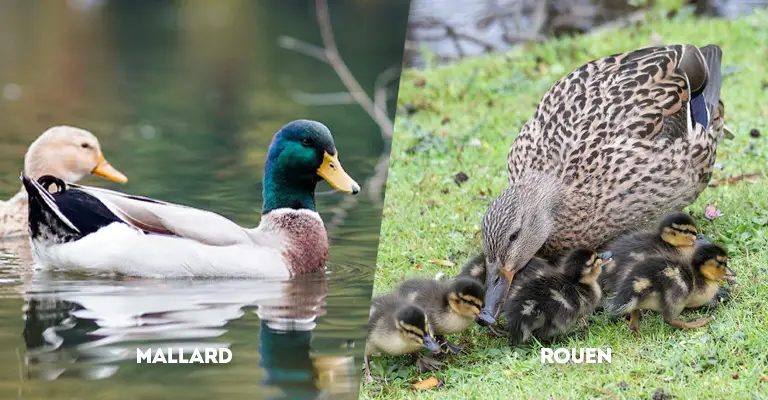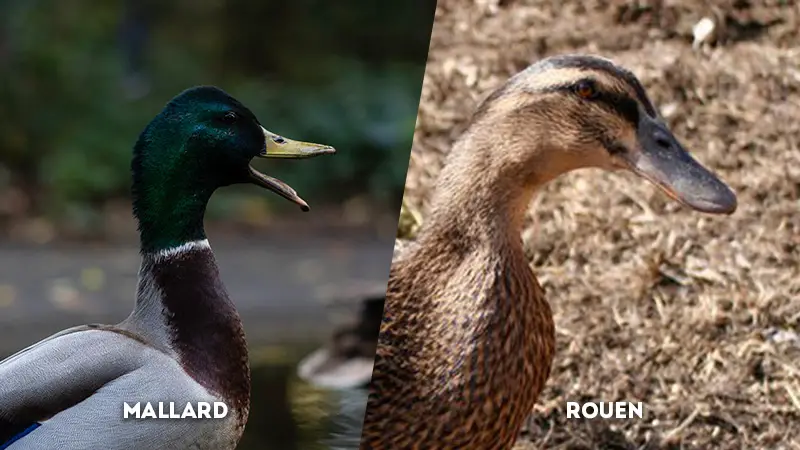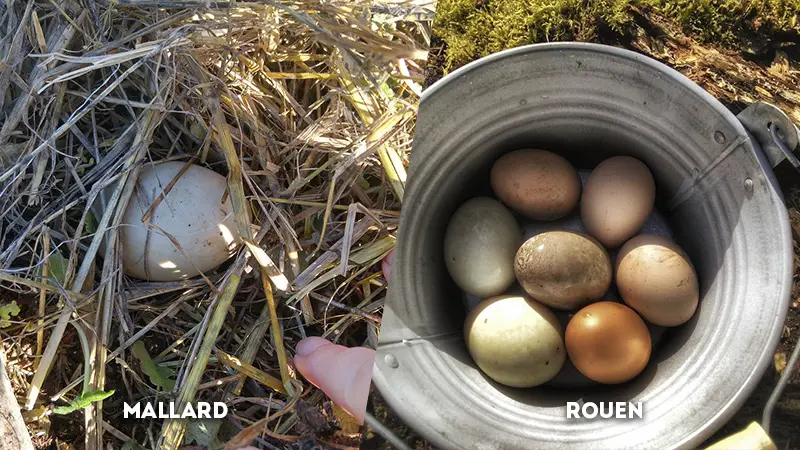In the dynamic world of waterfowl, the Mallard and Rouen ducks stand as distinct representatives, each with its own evolutionary journey and unique attributes.
The Mallard, a globally distributed wild species, has shaped ecosystems and provided the genetic foundation for numerous domestic breeds. In contrast, the Rouen duck, a product of human intervention, boasts refined traits optimized for meat production.
This exploration delves into the nuanced differences between these species, spanning coloration, size, behavior, and purpose, shedding light on the intricate interplay between nature, domestication, and the demands of human societies.

Key Differences Between Mallard and Rouen Ducks
Here’s a list of key differences between the Mallard and the Rouen duck:
Species Origin
- Mallard Duck: The Mallard, scientifically known as Anas platyrhynchos, is a widely distributed wild duck species. Its habitat spans across various continents, including North America, Europe, Asia, and North Africa.
Mallards are recognized for their remarkable adaptability and their prominent role as the progenitors of numerous domestic duck breeds. - Rouen Duck: The Rouen duck, on the other hand, traces its origins to domestication. Derived from the Mallard ancestry, the Rouen duck emerged as a distinct breed in France. Named after the city of Rouen in Normandy, these ducks were selectively bred for specific traits, primarily meat production.
Coloration of Drakes
- Mallard Duck: The male Mallards, known as drakes, boast a distinct coloration that features a glossy green head, a white neck ring, and a chestnut-brown chest. The drake’s body is characterized by a gray hue, and its wings bear a vibrant blue patch known as the speculum.
- Rouen Duck: Rouen drakes share a color pattern similar to Mallard drakes, yet they often exhibit more intense and vibrant coloring.
The Rouen drake showcases a strikingly vivid green head, a white collar encircling the neck, and a claret-colored breast. This richer coloration sets them apart from their wild counterparts.
Coloration of Hens
- Mallard Duck: Female Mallards, referred to as hens, exhibit a mottled brown plumage that provides effective camouflage during nesting. This natural coloring aids in protecting their eggs and young from potential predators.
- Rouen Duck: The hens of the Rouen breed retain a similar mottled brown coloration akin to that of female Mallards. This serves as a testament to their shared ancestry. While their coloration is not as distinct as that of the drakes, it aligns with the purpose of maintaining a semblance of natural camouflage.
Size of Drakes and Hens
- Mallard Duck: The Mallard duck is characterized by a moderate size, with drakes typically weighing around 1 kilogram (approximately 2.2 pounds). Female Mallards, or hens, are slightly smaller than their male counterparts.
- Rouen Duck: A noticeable distinction between Mallard and Rouen ducks lies in their size. Rouen drakes are significantly larger and heavier, weighing approximately 4 to 5 kilograms (8.8 to 11 pounds).
The hens of the Rouen breed are also larger than the average Mallard hen, further highlighting the substantial size difference between the two breeds.
Primary Use
- Mallard Duck: The primary role of the Mallard duck in its natural state is ecological. As a wild species, Mallards play a crucial role in aquatic ecosystems. Their foraging habits help control insect populations, and their nesting activities contribute to wetland habitats’ health.
- Rouen Duck: The Rouen duck, in contrast, has been selectively bred for its suitability for meat production. Their larger size and plump bodies make them an ideal choice for culinary purposes. Rouen ducks are commonly raised on farms for their meat, aligning them with human culinary preferences.
Behavior
- Mallard Duck: Mallards exhibit characteristic dabbling behavior, foraging in water for aquatic plants, insects, and small fish.
They are migratory, often traveling long distances between breeding and wintering grounds. Mallards are also known for their ability to adapt to a wide range of wetland habitats. - Rouen Duck: Domesticated Rouen ducks typically display behaviors similar to other domestic duck breeds. They retain their natural tendencies for dabbling and foraging but are generally raised in controlled environments, such as farms or backyard settings.
Unlike wild Mallards, Rouen ducks are not migratory and do not engage in seasonal long-distance movements.
Quack Call

- Mallard Duck: The iconic “quack” call of the Mallard is a distinctive and recognizable sound in wetland environments. The quack is commonly associated with female Mallards, although drakes also produce softer quacking sounds.
- Rouen Duck: Rouen ducks, like many domestic duck breeds, retain the “quack” call, although the specific vocalizations can vary.
Their quacks might be similar in tone and cadence to that of Mallards, yet individual variations can emerge due to their domesticated lineage.
Egg Production

- Mallard Duck: In their natural habitat, Mallards are moderate egg layers. They typically lay clutches of eggs during the breeding season, with the female’s mottled plumage providing camouflage to protect the nest and eggs.
- Rouen Duck: Rouen ducks also exhibit moderate egg-laying tendencies. However, due to their larger size compared to wild Mallards, their egg production might be influenced by selective breeding for meat traits. The specific egg production capacity can vary among individual Rouen ducks.
Plumage Color
- Mallard Duck: Mallards possess a natural plumage coloration that serves as a form of camouflage in their wild habitats. Their mottled brown appearance provides effective concealment in aquatic vegetation, helping them evade predators and protect their young.
- Rouen Duck: The plumage color of Rouen ducks is a result of selective breeding for specific traits. While Rouens share a mottled appearance with wild Mallards, their domestication has led to more vibrant and consistent color patterns.
This intense coloring can vary among individual Rouen ducks, showcasing the influence of genetic and selective breeding factors.
Pattern Consistency
- Mallard Duck: Mallards, as wild species, exhibit natural variation in their coloration and patterns due to genetic diversity. This variability allows them to blend into diverse wetland environments, providing essential camouflage for survival.
- Rouen Duck: The Rouen duck breed demonstrates a higher level of pattern consistency compared to Mallards. Through selective breeding, specific color and pattern traits have been refined and maintained within the Rouen population.
This consistency is evident in their more uniform appearance, which is beneficial for breeders seeking predictable characteristics in their domestic ducks.
Hunting
- Mallard Duck: Mallards have a significant presence in hunting culture, as they are among the most popular game birds pursued by waterfowl hunters. Their widespread distribution, striking plumage, and migratory behavior make them a prized target for hunters in various regions.
- Rouen Duck: Rouen ducks are not typically associated with hunting activities. Due to their domestication, they lack the behaviors and instincts that drive wild Mallards to migrate and exhibit other survival strategies. Instead, Rouen ducks are predominantly raised for meat production in controlled environments.
Natural Habitat
- Mallard Duck: Mallards inhabit a wide range of natural wetland habitats, including ponds, lakes, rivers, marshes, and estuaries. Their adaptability allows them to thrive in both freshwater and brackish water ecosystems.
- Rouen Duck: Rouen ducks have been adapted to domesticated settings and are often raised on farms, ponds, or backyard environments. While they share some habitat traits with wild Mallards, their primary environment is shaped by human care and management practices.
Lifespan
- Mallard Duck: In the wild, Mallards typically have a lifespan of around 5 to 10 years. Survival rates can vary due to factors such as predation, habitat conditions, and disease.
- Rouen Duck: Domestic Rouen ducks are likely to have a similar lifespan to their wild counterparts if properly cared for. However, their lifespan might be influenced by husbandry practices, diet, and access to veterinary care in domesticated environments.
Feeding Habits
- Mallard Duck: Mallards are dabbling ducks known for their versatile feeding habits. They forage in water, using their bills to filter aquatic plants, insects, and small aquatic animals from the water’s surface and bottom.
- Rouen Duck: Rouen ducks retain the natural dabbling behavior of their wild ancestors. However, their feeding habits might be influenced by their domestication and the availability of commercial duck feed. Rouen ducks raised on farms are often provided with formulated diets to optimize their growth and meat production.
Market Purpose
- Mallard Duck: In its wild state, the Mallard has no specific market purpose beyond its ecological role in maintaining wetland ecosystems.
However, the Mallard’s status as a progenitor of domestic duck breeds underscores its indirect influence on the market for duck products. - Rouen Duck: The Rouen duck is primarily raised for meat production, emphasizing its role in the culinary market. The breed’s larger size and well-fleshed body make it a favored choice for meat-oriented farming operations, contributing to the market demand for duck meat.
Feather Growth

- Mallard Duck: Wild Mallards undergo feather molting and replacement in a natural seasonal cycle. This process allows them to maintain optimal feather condition for various activities, including migration and reproduction.
- Rouen Duck: Similar to other domestic duck breeds, Rouen ducks also undergo feather molting and replacement. However, due to their domestication and the controlled environment in which they are raised, the timing and extent of feather growth might differ from their wild counterparts.
Maturity Age
- Mallard Duck: Mallards typically reach sexual maturity around 1 year of age. This timing aligns with their natural breeding cycle and seasonal reproductive behaviors.
- Rouen Duck: The maturity age of Rouen ducks is similar to that of Mallards, with individuals generally reaching sexual maturity at around 7 to 8 months. This timing is consistent with the needs of domestic breeding operations and aligns with the goal of achieving optimal reproductive performance.
Weight Gain
- Mallard Duck: Wild Mallards experience gradual weight gain as part of their natural development. Their weight is influenced by factors such as diet, migration patterns, and environmental conditions.
- Rouen Duck: Rouen ducks are bred for rapid weight gain and enhanced meat production. Compared to wild Mallards, their weight gain is more rapid and controlled, thanks to selective breeding for specific growth traits.
Size Variation
- Mallard Duck: Wild Mallards exhibit natural size variation due to genetic diversity and environmental factors. This variation allows them to adapt to a wide range of habitats and ecological niches.
- Rouen Duck: Selective breeding has minimized size variation among Rouen ducks. This breeding approach has led to a more uniform size within the breed, making it easier for producers to predict and manage their growth and meat yield.
Selective Breeding
- Mallard Duck: In the wild, natural selection and genetic diversity drive the evolution of Mallards. Traits that provide survival advantages, such as camouflage and flight capabilities, are selected for over time.
- Rouen Duck: The Rouen duck breed is a product of deliberate selective breeding by humans. Breeders have chosen specific individuals with desired traits such as size, meat yield, and consistent coloration to create a standardized breed with predictable characteristics.
This human-driven evolution contrasts with the natural selection processes in the wild.
Mallard Vs Rouen: Comparison Table
| Aspect | Mallard Duck | Rouen Duck |
|---|---|---|
| Species Origin | Wild duck species found globally. | Domestic breed derived from Mallard ancestry. |
| Coloration (Drakes) | Green head, white neck ring, brown chest. | Intense green head, white collar, claret chest. |
| Coloration (Hens) | Mottled brown for camouflage. | Similar to Mallard hens, mottled brown. |
| Size (Drakes) | Moderate, about 1 kg (2.2 lbs). | Larger, around 4-5 kg (8.8-11 lbs). |
| Size (Hens) | Slightly smaller than drakes. | Smaller than drakes, still larger than Mallard. |
| Primary Use | Wild habitat, domestic breeding ancestor. | Meat production due to size. |
| Behavior | Wild, migratory, diverse wetland habitats. | Domesticated, often raised on farms. |
| Quack Call | Distinctive “quack” sound. | Similar “quack” to other domestic ducks. |
| Egg Production | Moderate egg layers. | Moderate egg layers. |
| Plumage Color | More subdued, natural for camouflage. | Vibrant, intense coloration. |
| Pattern Consistency | Variable due to wild genetics. | Consistent in appearance due to breeding. |
| Hunting | Popular game bird. | Not typically hunted due to domestication. |
| Natural Habitat | Various wetlands and water bodies. | Farms, ponds, and backyard settings. |
| Lifespan | Around 5-10 years in the wild. | Similar lifespan in domesticated settings. |
| Feeding Habits | Dabbling, foraging in water. | Similar to other domestic duck breeds. |
| Market Purpose | Breeding for domestic ducks. | Meat production for culinary use. |
| Feather Growth | Seasonal molting and replacement. | Similar to other domestic ducks. |
| Maturity Age | Reach sexual maturity around 1 year. | Similar to Mallards, around 7-8 months. |
| Weight Gain | More gradual weight gain in wild state. | Faster weight gain in domestication. |
| Size Variation | Natural variation based on genetics. | More uniform size due to selective breeding. |
| Selective Breeding | Limited human influence in wild. | Bred for specific traits in domestication. |
Frequently Asked Questions
While both Rouen and Mallard ducks undergo feather molting and replacement, the controlled environment of domestication might influence the timing and extent of feather growth in Rouen ducks, potentially differing from their wild counterparts.
The primary purpose of raising Rouen ducks is meat production. Their larger size and well-fleshed bodies make them a favored choice for culinary use, contributing to the demand for duck meat in the market.
Yes, Mallard ducks exhibit natural size variation due to genetic diversity and environmental factors. This variation allows them to adapt to various habitats and ecological conditions.
The maturity age of Rouen ducks is similar to that of Mallard ducks. Both species generally reach sexual maturity at around 7 to 8 months, although this timing can vary among individuals and is influenced by factors such as breed and environmental conditions.
Selective breeding has led to a more consistent and vibrant coloration in Rouen ducks compared to their wild ancestors, the Mallards. This controlled breeding approach has refined and maintained specific color and pattern traits in the Rouen breed, resulting in a more uniform appearance.
To Recap
In the diverse tapestry of waterfowl, the Mallard and Rouen ducks serve as captivating examples of the intricate dance between the natural and the domesticated.
The Mallard’s resilience and role in ecosystems underscore its significance as a progenitor of diverse breeds. In contrast, the Rouen duck’s purposeful evolution embodies human ingenuity in crafting animals for specific needs.
Their distinct paths remind us of the dual forces shaping our world—nature’s wild complexity and humanity’s capacity for selective refinement. Together, they illustrate the timeless interplay of adaptation, human intervention, and the rich tapestry of life on Earth.